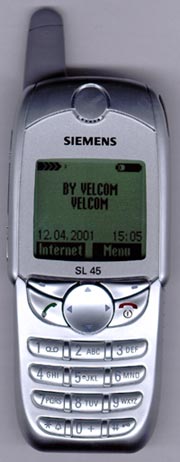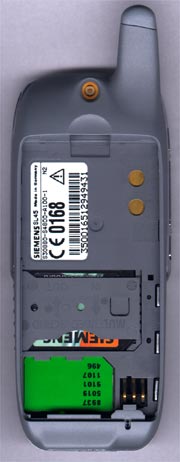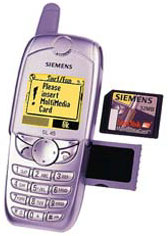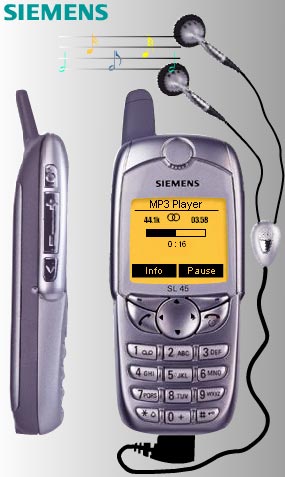 |
||
|
||
| ||
 The mobile phone we are examining today implements functions of a MP3 player, a digital dictaphone, an organizer (Outlook friendly), a portable data carrier, not counting a GSM 900/1800 phone, - all in one compact silver case. Complete setThe SL45 ships in a semi-transparent plastic box, which contains the following components:
The set is excellent: there is everything you need. The Manual is written competently, and a short booklet will suit those who don't like long descriptions. The headphones can be used as "hands-free" for listening to MP3 music. Voice dialing and voice instructions activate the player and the dictaphone. If you receive an incoming call during listening to MP3, the music becomes quieter, and the headphones can be used for talking. A clip where the mic and the control button are located contains also a mount for the headphones, and if you fix one headphone, you will get a "handsfree" for one ear. If you are tired of listening to music, then you can fasten both headphones not to let them hang loosely. The only disadvantage of such solution is lack of volume control and a rewind button on the clip. But anyway, it doesn't make much trouble. The cradle has two connectors. One is meant for charging, the other is for connecting to a PC. Connection with a computer is possible only if a charger is connected. You can charge the phone both in the cradle and by connecting the charger right to the phone. The charging unit is rather compact and convenient in use. You can easily take it with you. The full charging of the battery takes approximately 2 hours. The CD contains the software for connecting to a PC, for synchronization with the Outlook, and the whole documentation. "Look and feel"A stylish front panel and a keypad are made of smooth aluminum. The rear panel, which is at the same time a lid of the battery compartment is made of plastic. The assembly quality reveals nothing to complain about.  The antenna is small, it is in fact a part of the case. It is impossible to break it off accidentally, and it makes no problems. The SIM-card is fixed with two juts of the case on the one side and with a spring clamp on the other. It is a simple, and reliable construction. The phone fits the hand excellently, but operation with the keypad, especially with a low raw, causes some difficulty, unlike the operation with the control buttons. Most of all I liked the arrangement of control buttons. It is very similar to the Nokia model. It is much more pleasant to work with this phone with four vague rubber buttons of the S35i. The scrolling button has 4 positions. The lower one will bring you into the phone book, the right position will display the menu. The scrolling button can be also chosen for working with submenus. The buttons are pressed distinctly and have a tactile feedback. One of two control buttons can be set for any frequently used function. Besides, you can lock the keypad by pressing and holding the below right button. Auto locking is also possible. On the left side there are buttons for activation of a dictaphone, an MP3 player and a duplex volume control button. The IR port is located on the right. I'm pleased that Siemens have developed exactly such layout for its new models. I have been using the Nokia, and I was annoyed of the layouts of older models from Siemens. And the SL45 seems to be more pleasant in operation than even the Nokia 6210. Dimensions, weight, batteryThe phone is equipped with a great deal of various features, but it weighs only 88 g. The dimensions are also impressing: 105x46x17 mm. It will perfectly suit a pocket of trousers or a shirt. A standard Li-ion battery has 540 mAh capacity. The standby time is specified as 60 - 170 hours, the talktime is 60 - 240 minutes. At the moderate utilization the phone works at least two days, but when highly loaded it will serve you 1 day. Since the battery is Li-ion, you can charge the phone without waiting until it finishes charging. MultiMediaCard The main peculiarity of the phone is support of the MultiMediaCard. It is in fact a compact flash card. The phone is supplied together with a 32 MBytes card. But the phone can be upgraded up to a 64 MBytes. By the way, the same cards are used in the PDA Palm m500 and m505. The most pleasant thing is that the phone can work without the card. In this case you lose a dictaphone and an MP3 player. Besides, a standard address book gets automatically switched to the book in the SIM-card. On the left side of the case there is a hole through which you can draw out the card with any sharp stuff like a fastener. The card stores different system and user files. They are interface languages, bases for predicative texting (T9), start animations, an address book, an SMS archive, dictaphone records, MP3 music and a full instruction for the phone in the PDF format! PC connectionFor connection to a computer you must use a cradle for data exchange - a standard serial port (CĪM). Besides, there is an IR port for the same purpose. The drivers are installed flawlessly even under the Windows2000. After the installation a new detachable device 'Mobile' appears in 'My Computer'. By clicking it you can see the contents of the MultiMediaCard. For recording an MP3 composition you must only drag file into the MP3 folder. You can also create your own folder and record there whatever you want. It means that this phone can carry small volumes of data. It should be noted that a file on the card can't be open immediately: it must be preliminary rewritten to a hard disc. Besides, the Explorer's window gets one more button for converting files from the dictaphone's format to WAV and for conversion of SMS into usual test. But, there is a fly in the ointment: it is a low data transfer rate. Recording and reading of large volumes of data is an exercise for patient people. The Siemens QuickSync application included in the complete set synchronizes the phone with the Microsoft Outlook. But unfortunately, I failed to check how it operated. ScreenThe screen is quite large, high contrast, contains up to 7 lines of text. The whole integrated tip system is implemented in the form of hypertext and reminds operation with WAP. It must be very convenient to use due the the large amount of the data displayed. Amber-colored backlight is gradually switched off. There is nothing to find fault with. MenuAfter pressing the hang-up button you can see a screensaver with dolphins and an animation with a radar indicating the network search (it doesn't take much time). After being enabled, the phone transfers all numbers from SIM to the MultiMediaCard. A telephone book is quite large: you can store up to 500 addresses with 14 writing fields in each. You can add a mobile, work, home number, E-mail, postal addresses and other stuff. You can get into the menu by pressing the control button or by setting the scrolling to the right position. Navigating submenus is also implemented with the help of the scrolling or the control button. The menu is realized as a multilevel hierarchical structure. But as compared with the Nokia, the menu is a bit complicated. You can switch a fast menu to display the most frequently used options, which maybe accessed with numeric keys. The only drawback is that the key on a numeric pad that corresponds to a certain option isn't displayed. There is also a mode where a pictogram and a caption is displayed on each menu screen, like in the Nokia. Connection qualityIn my opinion, the connection quality is quite good. The volume of the speakers is enough, but some reserve would come in handy. The sensitivity is also not bad. There is a connector for an external antenna for using the phone with a automobile set. Dictaphone and autoresponderThe dictAphone is a really very good solution: the recording time is limited only by the free space on the MultiMediaCard (one hour - some 1200 KBytes). Sound can be recorded both during a call, and in the standby mode. It is very useful feature especially when someone dictates you an address or a phone number or some other important information. You just press one of the side buttons to record the conversation. Then you can reproduce it or rewrite it on another data storage device. Here you can record a lecture, an interview, a presentation or even an excursion. Sound transfer to a computer is very simple. If a conversion mode is enabled, then you can get a usual WAV file by copying the file from the dictaphone to a disc. By the way, the Card already contains a demo London City Guide that lasts 40 minutes. As for an autoresponder mode, it is a usual voice mail box. It's very useful if incoming calls are free as it allows saving on checking of the voice box. The only restriction is that the phone must be in the service zone for the autoresponder to work. MP3 player The card has initially several compositions. The Manual says that files can be recorded on the card but can't be rewritten back to a computer. It is a strange thing since both functions worked flawlessly. Music playback quality is like in a traditional MP3 player. But with a standard 32 MBytes card the space is unsufficient. The card contains a lot of system files leaving only 16 MBytes free. But you can delete everything unnecessary, for example, demos and interface languages. Another downside is a low data receiving rate. A 1-minute audio file of 128Kbit stereo gets loaded at 3.5 minutes! Besides, an incoming call will make you start from the beginning. OrganizerA large screen makes interaction quite pleasant. A calendar can be displayed in a month or week mode. In the month mode the picture looks like a usual calendar, in the week mode a day line will show you all activities planned for this week. Any activity can be set to appear once in a certain period of time, for example, once a week, month, year or on some definite days of week. A business card function is also a handy option. Once written your contact data, you can send them to other cellular phone or a computer via an IR port. Sound and vibracallHere one can find 39 variants of calls plus 3 own melodies, as well as what is recorded on the MultiMediaCard. After the Nokia's calls all ring tones of the SL45 seem a bit dull and monotonous. But you can create your own melody. The ring is not very load, but is quite enough. It is interesting that all ring tones are stored in the MIDI format. A vibra call is of average power. You can perfectly feel it in a pocket of jeans or a shirt. Apart from the vibration, operation of a vibra-motor is heard quite well. SMSFor phones of this class the support of the T9 predicative texting is a standard. Apart from it there are customizable message patterns. It is very pleasant that a lot of messages can be stored in the Flash card. The T9 bases are kept in separate files, and you can extend or renew them. GamesThere are 6 games in the phone, and they are either logical, like Reversi, or 2-dimensional labyrinths with a running face. Nothing extraordinary. I think that a 3D labyrinth and the Minesweeperin of the C35 look more playable. Seconds counter, calculator, currency converterThe seconds counter can store in memory intermediate values and can work in a background mode. There is also a reverse timer. The calculator implements all basic math operations and converts currency. ConclusionFor today it is the most advanced phone on the market. It is not yet a
smartphone, but not a simple phone either. MP3 playback, MultiMediaCard,
a normal dictaphone, a metallic case and a rich complete set make the Siemens
SL45 very attractive. The only noticed disadvantage is a low data transfer
speed making usage of the MP3 player not very convenient. The price of
this phone is fully at the level of the Siemens SL45. Write a comment below. No registration needed!
|
Platform · Video · Multimedia · Mobile · Other || About us & Privacy policy · Twitter · Facebook Copyright © Byrds Research & Publishing, Ltd., 1997–2011. All rights reserved. |